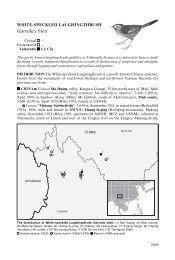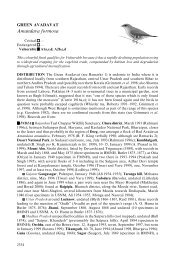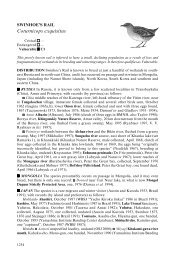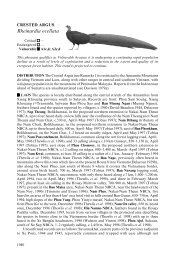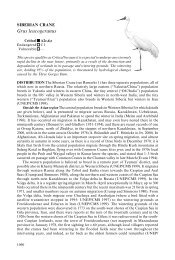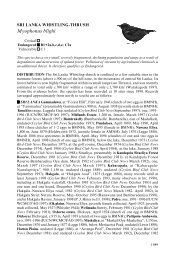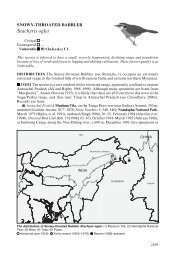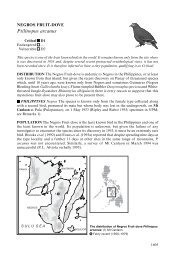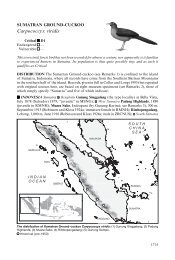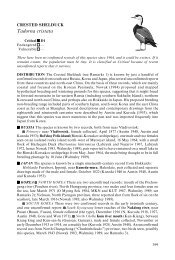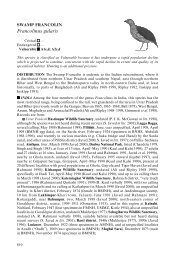Gyps bengalensis - BirdBase
Gyps bengalensis - BirdBase
Gyps bengalensis - BirdBase
You also want an ePaper? Increase the reach of your titles
YUMPU automatically turns print PDFs into web optimized ePapers that Google loves.
<strong>Gyps</strong> <strong>bengalensis</strong><br />
rumped and 31% Indian Vulture in 1985–1986, compared to 63% and 37% respectively in<br />
1998–1999 (Prakash 1999a).<br />
Calcium deficiency Nutritional bone disease in chicks, perhaps as a result of calcium<br />
deficiencies, has been reported for Cape Vultures in southern Africa, possibly associated<br />
with declining populations of bone-crunching hyenas Crocuta crocuta and Hyaena brunnea<br />
(Evans and Piper 1981; but see Dobbs and Benson 1984). Hyena H. hyaena populations have<br />
also declined in India, but this is not considered to be a likely cause of the decline in vulture<br />
populations (Prakash 1999a).<br />
Reduced nesting habitat In Keoladeo National Park, India, there has been a general decline<br />
in the number of old and mature trees available for nesting, but this is considered unlikely to<br />
explain the steep population decline observed this species (Prakash 1999a). In 1999, more<br />
than 4,000 potential nesting sites in the park were estimated, so there appeared to be no<br />
shortage (Rahmani and Prakash 2000a,b). Elsewhere, felling of trees used for roosting and<br />
nesting sites, particularly in urban areas (e.g. Agra, Rajasthan, since 1981), may have<br />
contributed to population declines (Satheesan 1999, 2000a). In the Sundarbans, Bangladesh,<br />
“most of the trees... which are suitable for nesting and roosting have been destroyed in the<br />
areas where the colonies are situated”; destruction of nesting trees, plus human disturbance,<br />
were identified as the main threats to colonies elsewhere (Sarker 1987b). In Gujarat, India,<br />
the loss of large trees for nesting was identified as a major cause of population declines in<br />
this species in the mid-1990s, with public parks in cities providing one of the few remaining<br />
sources of nesting habitat (Kacher 1996).<br />
Nest predators In the Sundarbans, Bangladesh, nests at a low height (owing to intense<br />
competition for higher nesting sites) were found to be particularly vulnerable to eggdepredation<br />
by monitor lizards, pythons and carnivorous mammals (Sarker 1987b).<br />
Hunting It is unlikely that direct hunting of vultures threatens them because they are<br />
regarded as unclean by people, and are not generally eaten (Rahmani 1998b). Virtually no<br />
hunting or trapping of vultures occurs in the Thar desert, Rajasthan (Rahmani 1996b).<br />
However, vulture eggs, chicks and adults were caught for food with nets, nooses and using<br />
bare hands, in a number of areas including: Guntur and Prakasam districts, Andhra Pradesh,<br />
until 1980 (K. M. Rao 1992, Satheesan 2000b); Bapne near Bombay (Satheesan 1999); villages<br />
near Sasan Gir in Gujarat (Satheesan 1999); Vishwaneedam near Bangalore (Satheesan 1999);<br />
and in Madhya Pradesh where honey gatherers collected eggs and chicks (presumably of<br />
Indian Vulture) on cliffs (Satheesan 1999, Thiollay 2000). Locally, threats may arise from<br />
the use of vulture remains as a source of “medicines”; newspaper reports have claimed that<br />
villagers have been offered up to Rs 3,000 for vulture bodies, leading to “massive vulturehunting<br />
sprees” (Ghatak 1999), but this seems unlikely to be a widespread threat. Similarly,<br />
small numbers are apparently caught for pets or for display in circuses (S. M. Satheesan in<br />
litt. 2000). In Bangladesh, there is a local superstition that hanging a vulture’s head around<br />
the neck of a cow will reduce maggot infestations in wounds during the rainy season, and<br />
hence some hunting of vultures occurs for this purpose (Sarker 1983).<br />
Aircraft strikes Mortality due to collision with aircraft has been a long-recognised hazard<br />
at airports in India (Ali and Grubh 1984, Thiollay 2000), particularly at Delhi, Bombay,<br />
Calcutta, Hyderabad, Madras, Trivandrum and Bangalore (Satheesan 1989b), with at least<br />
15 military aircraft and several human lives being lost due to vulture strikes during 1980–<br />
1994 (Satheesan 2000a), and vultures being involved in 39% of 265 aircraft strikes recorded<br />
by Ali and Grubh (1984). Several measures have been taken to eliminate populations near to<br />
airports to reduce the hazard to aviation, including direct killing of vultures, modernising of<br />
nearby slaughterhouses, and banning of carcass dumping (Satheesan 1999, Rahmani and<br />
Prakash 2000b). More than a decade ago population declines as a result of these measures<br />
had been noted in White-rumped and Indian Vultures in a number of urban areas (Satheesan<br />
2000a).<br />
609



